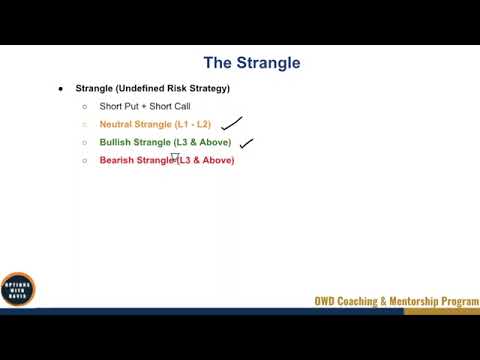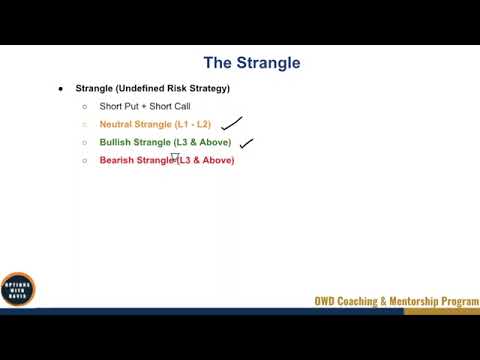In this video, “3-6 The Strangle Strategy,” Porsche explains the details of the strangle strategy and its three variations: neutral, bullish, and bearish. The strangle strategy is an undefined risk strategy that involves a short put and a short call. In a neutral strangle, the short strikes should be between 16 to 20 deltas, and the premium should be at least 5% to 10% of the buying power reduction (BPR). The exit point is typically at 21 days till expiration (DTE) with a potential profit of up to 80% of the maximum profit. To limit the maximum loss, it is recommended to cut off the strangle when it hits the initial BPR. The capital allocation for the strangle should be limited to 50% due to potential changes in BPR. In a bullish strangle, the short puts are shifted further up and the short calls are closer to the money, while in a bearish strangle, the short puts are close to the money and the short calls are further out. Increasing the short call deltas reflects a more bearish position.
Overall, the article provides valuable guidelines for implementing the strangle strategy in different market conditions to maximize potential profits and manage risk effectively. Porsche’s explanations and examples make it easy to understand and apply the strategy to your own trading. Whether you are a seasoned trader or new to options trading, this video is definitely worth watching for valuable insights and strategies.
1. Introduction to the Strangle Strategy
The strangle strategy is a popular options trading strategy that falls under the category of an undefined risk strategy. It involves selling both a short put and a short call, without any long option protection. This makes it a pure undefined risk strategy, as there are no long options to limit the potential losses.
There are three types of strangles: neutral, bullish, and bearish. Each type is used in different market conditions and requires different adjustments and decision-making strategies. In this article, we will explore each type of strangle in detail, discussing the specific guidelines and considerations for each.
1.1 What is the Strangle Strategy?
The strangle strategy is an options trading strategy that involves selling both a short put and a short call on the same underlying asset. The short puts and short calls are typically placed out-of-the-money, meaning they have strike prices that are above (for short puts) or below (for short calls) the current market price of the underlying asset. This strategy allows traders to profit from a rangebound market or high volatility, while also exposing themselves to unlimited risk.
The goal of the strangle strategy is to take advantage of the time decay (theta decay) of the options. As time passes, the value of the options decreases, allowing the trader to keep the premium received when selling the options.

1.2 Types of Strangles
There are three main types of strangles: neutral, bullish, and bearish. Let’s take a closer look at each type and the market conditions in which they are typically used.
-
Neutral Strangle: This type of strangle is used when the trader expects the underlying asset to remain within a certain range. The short strikes for a neutral strangle are typically set anywhere from 16 to 20 deltas, with the intention of maximizing premium received. The goal is to profit from theta decay while minimizing risk.
-
Bullish Strangle: A bullish strangle is used when the trader expects the underlying asset to move upwards or remains neutral. In a bullish strangle, the short puts are shifted further up, while the short calls are closer to the money. This adjustment reflects the trader’s bullish sentiment and allows them to profit if the market moves in their anticipated direction.
-
Bearish Strangle: A bearish strangle is used when the trader expects the underlying asset to move downwards or remains neutral. In a bearish strangle, the short puts are close to the money, while the short calls are shifted further out. This adjustment reflects the trader’s bearish sentiment and allows them to profit if the market moves in their anticipated direction.
Each type of strangle requires specific adjustments, market analysis, and decision-making strategies. Let’s explore each type in more detail.
2. Neutral Strangle
2.1 Short Strikes and Deltas
In a neutral strangle, the short strikes are typically set anywhere from 16 to 20 deltas. The trader can choose the specific delta based on their risk tolerance and market analysis. The higher the delta, the closer the short strikes will be to the current market price of the underlying asset. It is important to note that the higher the delta, the higher the risk and potential loss.
2.2 Premium Requirement
For a neutral strangle, the premium received should be at least 5% to 10% of the buying power reduction (BPR). The premium received will depend on the volatility of the underlying asset. Higher volatility will result in a higher premium, while lower volatility will result in a lower premium. It is important to assess the premium in relation to the BPR to ensure that it meets the desired risk-reward ratio.
2.3 Exit Strategy
In a neutral strangle, the recommended exit point is 21 days till expiration (DTE). However, traders have the flexibility to exit earlier if they choose to. Exiting at 21 DTE ensures that there is sufficient time for theta decay and allows the trader to capture the majority of the premium received.
2.4 Take Profit
In a neutral strangle, the take profit target can be higher than in an iron condor strategy, reaching up to 80% of the maximum profit. This is because the strangle strategy does not have the same friction from long options that the iron condor does. The pure theta decay of the options allows for higher potential profits.
2.5 Maximizing Profit and Minimizing Loss
To maximize profit and minimize loss in a neutral strangle, it is important to monitor the position closely and implement risk management strategies. One approach is to cut off the strangle when it hits the initial BPR to limit the maximum loss. This acts as a hard stop loss point and protects the trader from excessive risk.
Additionally, capital allocation should be limited to 50% of the total capital to account for potential changes in the BPR. The BPR can fluctuate with market volatility, and allocating a significant portion of capital could result in margin calls. By limiting the capital allocation, traders can protect themselves from excess risk and adapt to changing market conditions.
3. Bullish Strangle
3.1 Adjusting Short Puts and Short Calls
In a bullish strangle, the short puts are shifted further up, while the short calls are kept closer to the money. This adjustment reflects the trader’s bullish sentiment and allows them to profit if the market moves in an upward or neutral direction. The specific delta for the short puts can range from 25 to 40, depending on the trader’s risk tolerance and market analysis. The short call delta is typically set around 5 to 10.
3.2 Market Analysis and Decision-making
When placing a bullish strangle, it is important to conduct thorough market analysis and make informed decisions. Traders should assess the current market conditions, trend, and volatility before determining the appropriate adjustments for the short puts and short calls. This analysis will help identify the optimal deltas and strike prices for the strangle.
3.3 Increasing Bullishness as the Market Goes Down
As the market goes down further, traders can increase their bullishness by adjusting the deltas of the short puts and keeping the short call deltas low. For example, if the market moves from Level 3 to Level 4, where Level 3 is a moderate downward movement, the trader can increase the short put delta to 30, while keeping the short call delta at 10. This adjustment allows the trader to capture more downside potential while still maintaining a bullish bias.
4. Bearish Strangle
4.1 Shifting Short Puts and Short Calls
In a bearish strangle, the short puts are placed close to the money, while the short calls are shifted further out. This adjustment reflects the trader’s bearish sentiment and allows them to profit if the market moves in a downward or neutral direction. The specific delta for the short calls can range from 5 to 40, depending on the trader’s risk tolerance and market analysis. The short put delta is typically set around 5 to 10.
4.2 Market Analysis and Decision-making
Similar to the bullish strangle, a bearish strangle requires thorough market analysis and informed decision-making. Traders should assess the current market conditions, trend, and volatility before determining the appropriate adjustments for the short puts and short calls. This analysis will help identify the optimal deltas and strike prices for the strangle.
4.3 Increasing Bearishness as the Market Goes Higher
As the market goes higher, traders can increase their bearishness by adjusting the deltas of the short calls and keeping the short put deltas low. For example, if the market moves from Level 3 to Level 4, where Level 3 is a moderate upward movement, the trader can increase the short call delta to 30, while keeping the short put delta at 10. This adjustment allows the trader to capture more upside potential while still maintaining a bearish bias.
5. Capital Allocation and Risk Management
5.1 Limiting Capital Allocation
When implementing the strangle strategy, it is important to limit capital allocation. Allocating a significant portion of capital to strangles can be risky, especially in highly volatile markets. To account for potential changes in the buying power reduction (BPR), it is recommended to limit capital allocation to 50% of the total capital. This allows traders to adapt to changing market conditions and protects them from excessive risk.
5.2 Potential Changes in BPR
The buying power reduction (BPR) can fluctuate with market volatility. As the volatility increases, the BPR can also increase, requiring a higher allocation of capital. Traders should monitor the BPR closely and be prepared for potential changes. It is important to adjust capital allocation accordingly to avoid margin calls and manage risk effectively.
5.3 Risk Management and Max Loss Limit
Implementing risk management strategies is crucial when trading strangles. As an undefined risk strategy, the strangle does not have the same risk mitigation from long options as other strategies. It is recommended to have a max loss limit and cut off the strangle when it hits the initial BPR. This acts as a hard stop loss point and protects traders from excessive losses.
Monitoring the position closely, implementing exit strategies, and practicing disciplined risk management are key to successful trading with the strangle strategy.
6. Conclusion
The strangle strategy is a versatile options trading strategy that allows traders to profit from a rangebound market or high volatility. By selling both a short put and a short call, traders can take advantage of theta decay and maximize premium received. The neutral, bullish, and bearish variations of the strangle strategy provide flexibility to adapt to different market conditions.
Understanding the specific guidelines and considerations for each type of strangle is essential to implement the strategy successfully. By adjusting short strikes and deltas, conducting thorough market analysis, and managing capital allocation and risk effectively, traders can optimize their trading outcomes.
Remember to always practice risk management and continuously monitor the position to make informed decisions. With discipline and a solid understanding of the strangle strategy, traders can navigate the options market with confidence and potentially achieve consistent profits.
